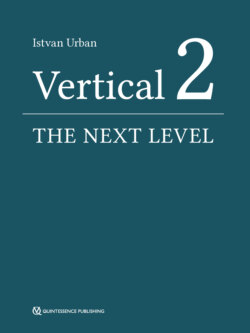Читать книгу Vertical 2: The Next Level of Hard and Soft Tissue Augmentation - Istvan Urban - Страница 13
На сайте Литреса книга снята с продажи.
II. Perforated vs non-perforated membranes using an osteoconductive graft material
ОглавлениеThis experiment focused on the vascularization and bone formation activity of the newly formed bone. A xenogenic bone graft was used without any growth factors or autogenous bone. The perforated membrane was used with and without a collagen membrane covering the non-perforated membrane (Figs 1-28 to 1-31). Each group demonstrated a similar amount of bone formation as well as soft tissue invagination (Figs 1-32 to 1-34). However, when the vascularized area of the regenerated ridge was examined, the perforated group demonstrated a tendency toward better vascularization (Fig 1-35 and Table 1-1).
Fig 1-22 Labial view of a dense membrane fixated around a chronic vertical defect.
Fig 1-23 Labial view of a perforated membrane fixated around a chronic vertical defect.
Fig 1-24 Bone morphogenetic protein-2 (BMP-2) is bound into a collagen carrier. No other graft is used.
Figs 1-25 and 1-26 Cross-sectional views showing bone formation in both groups just below the periosteum and above the membrane.
Fig 1-27 Graph showing bone growth of the perforated and non-perforated sites. The perforated membranes demonstrated significantly more bone growth.
Fig 1-28 Labial view of a xenograft placed on a chronic vertical defect.
Fig 1-29 Labial view of a fixated dense membrane.
Fig 1-30 Labial view of a perforated membrane.
Fig 1-31 Labial view of a perforated membrane covered with a collagen membrane.
The tendency of having less pseudoperiosteum formation has been seen in well-adapted sites, even in cases of perforated membranes (Figs 1-36 and 1-37). Since membrane adaptation seems to be important, a hybrid design PTFE mesh/membrane was tested clinically (Fig 1-38).
Figs 1-32 and 1-33 Cross-sectional views of the histologies of the regenerated bone after vertical ridge augmentation in this study.
Fig 1-34 Graph showing the bone formation of the three groups. No statistically significant differences were found.
Fig 1-35a and b The perforated group demonstrated a tendency toward better vascularization.
| Solid | Perforated | Perforated, covered with collagen |
| 2.44 | 8.33 | 7.93 |
| 7.22 | 8.41 | 4.40 |
| 2.77 | 11.26 | 6.58 |
| 13.83 | 12.41 | 5.54 |
| 4.76 | 5.64 | 2.48 |
| 2.30 | 3.62 | 4.24 |
| 7.07 | 10.62 | 5.77 |
| 3.58 | 6.87 | 1.89 |
| 5.50 | 8.40 | 4.85 |
Table 1-1 Table showing the tendency toward a better vascularized surface of the perforated group.
Figs 1-36 and 1-37 A well-adapted dense and perforated membrane showing minimal soft tissue ingrowth.
Fig 1-38 The membrane showed excellent performance in terms of clinical results as well as adaptability and retrievability.
Fig 1-39 Cross-sectional view of the osteocalcin (OCN) marker. The squares demonstrate the regions of interest (ROIs) that were investigated.
Fig 1-40 Graph showing the results of the OCN marker for the three groups investigated.
Fig 1-41 Cross-sectional view of the alkaline phosphatase (ALP) marker. The squares demonstrate the ROIs that were investigated.
Fig 1-42 Graph showing the results of the ALP marker for the three groups investigated.
Immunohistochemistry was also performed, looking at different markers. Of these markers, two demonstrated significantly better results. Osteocalcin (OCN – a marker for osteoblastic activity and level of mineralization) and alkaline phosphatase (ALP – a marker for osteoblastic activity and bone formation) had a significant presence (Figs 1-39 to 1-42).
Figs 1-43 BMP-2/xenograft: Sandwich configuration showing how the BMP-2 is sandwiched inside the xenograft particles (arrow).
Fig 1-44 BMP-2/xenograft: Lasagna configuration showing how the BMP-2 is layered on top of the graft and just below the perforated PTFE membrane (arrow).
These results indicate that the perforated group is more vascularized and has a more active formation. However, the collagen membrane coverage did not seem to be a prerequisite. In fact, the collagen membrane group demonstrated slightly worse results than the group without coverage. This was due to the collagen membrane of choice producing some inflammatory response. It is very likely that the other native type of collagen membranes could help in reducing soft tissue ingrowth. For this reason, the author uses a collagen membrane in conjunction with a perforated PTFE membrane.
